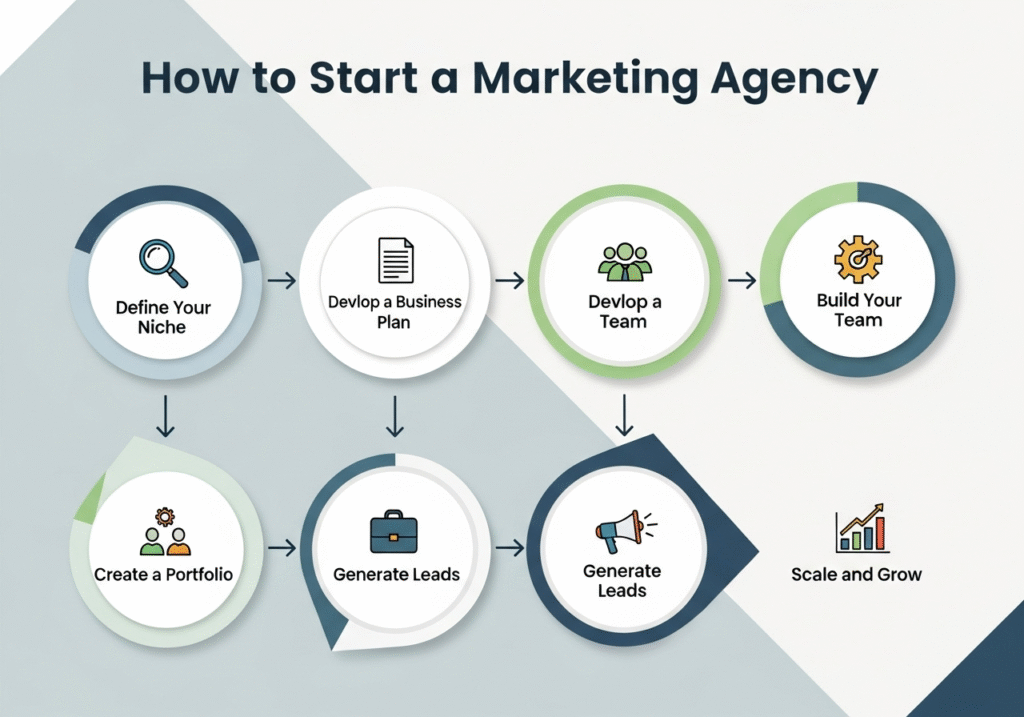Long-tail keywords are your secret weapon for dominating search results without competing against industry giants. These cutting-edge long-tail SEO methods help small businesses, content creators, and digital marketers capture highly targeted traffic that converts better than broad keywords.
Most websites chase competitive short keywords and wonder why they can’t break through. Smart SEO professionals know that long-tail keywords with lower search volume but higher intent drive better results. You’ll rank faster, attract qualified visitors, and see real business growth.
This guide covers advanced keyword research techniques that uncover profitable long-tail opportunities your competitors miss. You’ll learn content optimization strategies that turn long-tail keywords into traffic magnets. We’ll also dive into technical SEO enhancements that boost your long-tail rankings and help you measure success as you scale your efforts.
Stop fighting impossible battles for generic keywords. Start winning with targeted long-tail SEO strategies that actually work.
Understanding Long-Tail Keywords for Maximum Impact

Identify high-converting search phrases with low competition
Smart long-tail keyword selection starts with finding the sweet spot between search volume and competition. These phrases typically contain three to five words and capture specific user needs that broader keywords miss. High-converting long-tail keywords often include modifiers like “best,” “how to,” “near me,” or “reviews,” which signal strong purchase intent.
Use competitor gap analysis to uncover opportunities your rivals overlook. Tools like SEMrush and Ahrefs reveal keywords your competitors rank for on page two or three – prime targets for your cutting-edge long-tail SEO methods. Look for keywords with search volumes between 100-1,000 monthly searches and keyword difficulty scores below 30.
Geographic and demographic modifiers create powerful long-tail opportunities. Instead of targeting “marketing software,” focus on “marketing software for small businesses in Chicago” or “affordable email marketing tools for nonprofits.” These specific phrases face less competition while attracting highly qualified traffic.
Analyze user intent behind specific long-tail queries
Understanding search intent transforms your long-tail keywords SEO strategy from guesswork into precision targeting. Every long-tail query falls into four main categories: informational, navigational, commercial investigation, or transactional intent.
Informational queries like “how to improve website ranking naturally” indicate users seeking knowledge. These searchers aren’t ready to buy but represent top-of-funnel opportunities for building trust and authority. Create comprehensive guides and tutorials targeting these phrases.
Commercial investigation queries such as “best SEO tools comparison 2024” show users researching solutions before purchasing. These represent middle-funnel opportunities where comparison content, reviews, and feature breakdowns perform exceptionally well.
Transactional intent appears in phrases like “hire SEO consultant near me” or “buy keyword research software.” These bottom-funnel keywords convert at higher rates and justify more aggressive optimization efforts.
Leverage keyword research tools for untapped opportunities
Advanced SEO techniques require sophisticated tools that go beyond basic keyword planners. Answer The Public reveals question-based long-tail opportunities by showing what people actually ask about your topics. These question-format keywords often have lower competition and higher conversion rates.
Google’s “People Also Ask” and “Related Searches” sections provide real-time insights into long-tail variations users actively search for. Export these suggestions and analyze their search volumes using your preferred keyword research strategy tools.
Long-tail keyword mining through search console data reveals golden opportunities hiding in your existing traffic. Filter for queries with impressions but low click-through rates – these represent optimization opportunities for existing content or new content creation targets.
| Tool Category | Primary Use | Best For |
|---|---|---|
| Question Mining | Answer The Public, AlsoAsked | Informational content |
| Competitor Analysis | SEMrush, Ahrefs | Gap identification |
| Search Console | Google Search Console | Performance optimization |
| SERP Analysis | SurferSEO, MarketMuse | Content optimization |
Map long-tail keywords to your content funnel stages
Strategic keyword mapping aligns your long-tail discoveries with user journey stages, maximizing both traffic and conversions. Top-of-funnel content targets informational long-tail keywords that attract users beginning their research process.
Create awareness-stage content around phrases like “what is on page SEO” or “why do websites need search engine optimization.” These educational pieces establish your expertise while capturing users early in their decision-making process.
Middle-funnel content should target comparison and consideration keywords such as “WordPress SEO plugins comparison” or “freelance vs agency SEO services.” These pieces guide users toward your solutions while providing genuine value.
Bottom-funnel content optimization focuses on high-intent keywords like “SEO audit services pricing” or “local SEO consultant consultation.” These pages should emphasize conversion elements while maintaining helpful, non-pushy content approaches.
Website ranking strategies improve when you create content clusters around related long-tail keywords. Group similar intent keywords into topic clusters, with pillar pages targeting broader terms and cluster content targeting specific long-tail variations. This approach strengthens your topical authority while capturing traffic across the entire customer journey.
Advanced Long-Tail Keyword Research Techniques

Mine Competitor Content for Overlooked Keyword Opportunities
Smart competitor analysis goes beyond basic keyword tools. Start by identifying your top 10-15 competitors and examine their blog archives, FAQ sections, and product descriptions for long-tail keyword research strategy opportunities they might be underutilizing. Look for topics they’ve covered briefly but haven’t fully explored – these represent golden opportunities for your cutting-edge long-tail SEO methods.
Use tools like Ahrefs or SEMrush to analyze which keywords your competitors rank for on pages 2-5 of search results. These partially-ranking pages often contain valuable long-tail phrases that haven’t been fully optimized. Create comprehensive content around these overlooked opportunities to capture traffic your competitors are leaving on the table.
Pay attention to competitor comment sections and social media discussions. Customers often use specific language and phrases that reveal untapped long-tail keywords SEO potential. Screenshot these conversations and extract the exact terminology your target audience uses when discussing problems your product or service solves.
Use Google’s Autocomplete and Related Searches Strategically
Google’s autocomplete feature is a goldmine for advanced SEO techniques. Type your primary keyword into Google’s search bar and note every suggestion that appears. Don’t stop there – add modifiers like “how to,” “best,” “vs,” and “without” before your main keyword to uncover different angles.
The “People also ask” section reveals question-based long-tail opportunities perfect for content marketing SEO. Each question represents a specific search intent you can target with dedicated content sections or standalone articles.
Scroll to the bottom of search results to find “Related searches” – these show semantically related terms Google associates with your topic. Create a spreadsheet tracking these variations across different locations and devices, as Google personalizes suggestions based on search history and geographic location.
Use incognito mode and VPNs to see autocomplete suggestions from different regions. Local variations often reveal unique long-tail opportunities that broader keyword tools miss.
Extract Long-Tail Phrases from Customer Support Queries
Your customer support team sits on a treasure trove of SEO for long-tail keywords data. Review support tickets, live chat transcripts, and phone call summaries from the past six months. Customers describe their problems using natural language that perfectly matches how others search for solutions online.
Create categories for common issues and note the exact phrases customers use. Terms like “won’t work with,” “keeps crashing when,” or “alternative to” often become high-converting long-tail keywords because they capture specific pain points.
Export your help desk data and use text analysis tools to identify recurring phrases and terminology patterns. This approach reveals website ranking strategies opportunities that traditional keyword research tools can’t discover because they’re based on real customer language rather than search volume estimates.
Train your support team to flag unique or specific phrases customers use during interactions. This creates an ongoing system for discovering fresh long-tail opportunities as your market evolves.
Analyze Voice Search Patterns for Conversational Keywords
Voice search behavior differs significantly from typed queries. People speak more naturally and ask complete questions rather than using fragmented keyword phrases. This shift creates massive opportunities for conversational long-tail keywords.
Research shows voice searches are typically 3-5 words longer than text searches and often begin with question words like “how,” “what,” “where,” “when,” and “why.” Build content around these natural speech patterns to capture voice search traffic.
Use tools like AnswerThePublic to discover question-based keywords that align with voice search behavior. Focus on local intent phrases like “near me,” “open now,” and “directions to” if you serve local markets.
Monitor your analytics for longer, question-based queries that already bring traffic to your site. These indicate successful voice search optimization and reveal patterns you can replicate across other content areas.
| Voice Search Pattern | Example Keywords | Content Strategy |
|---|---|---|
| Question-based | “How do I fix…” | FAQ-style content |
| Local intent | “Best pizza near me” | Location-specific pages |
| Comparison queries | “iPhone vs Android which is better” | Detailed comparison articles |
| Problem-solving | “My laptop won’t start what should I do” | Step-by-step guides |
Content Optimization Strategies for Long-Tail Success

Create Topic Clusters Around Primary Long-Tail Keywords
Building topic clusters transforms scattered content into powerful SEO networks. Start by identifying your core long-tail keywords, then create comprehensive hub pages that cover broad topics while supporting pages dive deep into specific subtopics. For instance, if your primary keyword is “best organic skincare routine for sensitive skin,” your hub page covers general sensitive skincare, while cluster pages focus on “morning routines,” “evening routines,” and “seasonal adjustments.”
This approach signals topical authority to search engines while capturing traffic from various related searches. Users searching for long-tail keywords often want comprehensive information, making topic clusters perfect for satisfying search intent and keeping visitors engaged longer.
Optimize Meta Descriptions for Enhanced Click-Through Rates
Meta descriptions for long-tail keywords require a different approach than broad terms. Since long-tail searchers have specific intent, craft descriptions that directly address their exact needs. Include the complete long-tail phrase naturally while adding compelling value propositions.
Keep descriptions between 150-160 characters and front-load the most important information. Use action words like “discover,” “learn,” or “get” to create urgency. For a keyword like “how to remove pet stains from wool carpets,” your meta description might read: “Remove pet stains from wool carpets safely with these proven methods. Step-by-step guide includes household items you already own.”
Test different emotional triggers and value propositions to see what resonates with your specific audience segments.
Structure Content With Semantic Keyword Variations
Search engines understand context better than ever, making semantic keyword integration essential for long-tail success. Instead of keyword stuffing, weave related terms and synonyms throughout your content naturally. This approach captures additional search variations while improving readability.
Create a semantic keyword map for each piece of content, including:
- Primary long-tail keyword: Your main target phrase
- Secondary variations: Different ways people might search for the same information
- Related terms: Supporting vocabulary that adds context
- Question phrases: How users might phrase voice searches
Structure your content with these variations in headers, subheadings, and body text. Search engines reward content that comprehensively covers topics rather than focusing on single keywords.
Implement Schema Markup for Better Search Visibility
Schema markup gives search engines detailed information about your content, leading to rich snippets and improved visibility. For long-tail SEO, focus on schema types that match your content purpose:
- FAQ schema for question-based long-tail keywords
- How-to schema for instructional content
- Article schema for in-depth guides
- Product schema for commercial long-tail terms
Rich snippets can dramatically improve click-through rates, especially for long-tail searches where users want specific information quickly. A properly marked-up FAQ section can occupy significant search result real estate, pushing competitors down the page.
Build Internal Linking Networks Between Related Long-Tail Pages
Strategic internal linking creates content pathways that benefit both users and search engines. Link related long-tail pages using descriptive anchor text that includes target keywords naturally. This approach distributes page authority throughout your site while encouraging deeper exploration.
Create linking opportunities by:
- Cross-referencing related topics within content
- Building resource hubs that link to multiple related pages
- Adding contextual links within body content
- Creating “related articles” sections
Focus on relevance over quantity. Each link should provide genuine value to readers while supporting your SEO strategy. This network effect helps all your long-tail pages rank better collectively than they would individually.
Technical SEO Enhancements for Long-Tail Rankings

Optimize page loading speed for improved user experience
Page speed directly impacts how well your long-tail keywords perform in search results. When users search for specific, detailed queries, they expect quick answers. Google rewards fast-loading pages with better rankings, making speed optimization crucial for your cutting-edge long-tail SEO methods.
Start by compressing images without losing quality. Tools like TinyPNG or WebP format can reduce file sizes by up to 80%. Next, minimize CSS and JavaScript files by removing unnecessary code and combining multiple files into one. Enable browser caching so returning visitors don’t have to reload everything from scratch.
Consider using a Content Delivery Network (CDN) to serve your content from servers closest to your users. This simple change can cut loading times in half, especially for visitors from different geographical locations.
Database optimization plays a huge role too. Clean up unnecessary plugins, optimize your database tables, and implement lazy loading for images below the fold. These technical improvements directly support your search engine optimization efforts for long-tail targeting.
Create mobile-responsive designs for all devices
Mobile users make up over 60% of all searches, and they’re often looking for specific, long-tail solutions. Your mobile design needs to handle longer keyword phrases gracefully while maintaining fast performance across all screen sizes.
Focus on thumb-friendly navigation and readable font sizes. Long-tail keywords often appear in voice searches, so your mobile design should accommodate users who might be multitasking or moving around while searching.
Test your pages on various devices using Google’s Mobile-Friendly Test tool. Pay special attention to how your content displays on smaller screens – long-tail content tends to be more detailed, so ensure it remains scannable and digestible on mobile devices.
Implement Accelerated Mobile Pages (AMP) for content-heavy pages targeting long-tail keywords. While AMP isn’t mandatory, it can give you an edge in mobile search results, especially for informational queries where users seek detailed answers.
Implement proper URL structures for long-tail targeting
Your URL structure should reflect your long-tail keyword strategy while remaining clean and user-friendly. Instead of generic URLs like “/page123”, create descriptive paths that include your target keywords naturally.
Keep URLs under 60 characters when possible, but don’t sacrifice clarity for brevity. For long-tail targeting, descriptive URLs help both users and search engines understand your page content immediately.
Use hyphens instead of underscores to separate words in your URLs. Structure them hierarchically to show content relationships: /category/subcategory/specific-long-tail-topic. This approach supports your website ranking strategies by creating logical site architecture.
Avoid dynamic parameters and session IDs in URLs targeting long-tail keywords. Clean, static URLs perform better in search results and are easier for users to remember and share. Include your primary long-tail keyword near the beginning of the URL path for maximum SEO impact.
Set up proper 301 redirects if you change URL structures, ensuring you don’t lose any SEO value from existing long-tail keyword rankings.
Measuring and Scaling Your Long-Tail SEO Results

Track keyword rankings and organic traffic growth
Building a comprehensive tracking system forms the backbone of successful long-tail SEO campaigns. Start by setting up position tracking for your target long-tail keywords using tools like SEMrush, Ahrefs, or Google Search Console. These platforms reveal how your content performs across different search queries and geographic locations.
Create custom dashboards that segment your keyword performance by search intent, topic clusters, and content types. This granular approach helps identify which cutting-edge long-tail SEO methods work best for specific niches. Set up weekly rank tracking reports to catch momentum shifts early.
Google Analytics 4 provides deeper insights into organic traffic patterns from long-tail searches. Configure custom segments that isolate traffic from keywords containing three or more words. Monitor metrics like session duration, pages per session, and bounce rates specifically for long-tail traffic to understand user engagement quality.
Pay attention to featured snippet opportunities within your long-tail keyword portfolio. These zero-position results often drive significant traffic increases and brand visibility for well-optimized content pieces.
Monitor conversion rates from long-tail traffic
Long-tail traffic typically converts at higher rates than broad keywords, making conversion tracking essential for ROI measurement. Set up goal tracking in Google Analytics that captures micro and macro conversions from organic search visitors.
Create separate conversion funnels for different types of long-tail queries. Informational keywords might lead to newsletter signups or content downloads, while commercial intent keywords should track purchase completions or demo requests. This segmentation reveals which advanced SEO techniques drive the most valuable traffic.
Heat mapping tools like Hotjar or Crazy Egg show how long-tail visitors interact with your content. Users from specific long-tail searches often follow predictable behavior patterns that inform content optimization decisions.
Implement UTM parameter tracking for internal link clicks from long-tail landing pages. This data reveals how effectively your content guides visitors through the customer journey and identifies opportunities for strategic internal linking improvements.
Identify opportunities to expand successful content pieces
Successful long-tail content pieces often indicate broader topic opportunities worth exploring. Use content gap analysis tools to discover related keywords your competitors rank for but you don’t target yet. This competitive intelligence reveals expansion pathways that leverage your existing content authority.
Monitor the search query reports in Google Search Console to find unexpected long-tail variations driving traffic to your content. These organic discoveries often outperform researched keywords and suggest natural content expansion directions.
Create topic cluster maps around your highest-performing long-tail content. Build supporting articles that target semantically related keywords while linking back to your pillar content. This hub-and-spoke approach amplifies your website ranking strategies across entire topic areas.
Analyze user-generated content like comments, social media mentions, and customer support queries for language patterns. Real user vocabulary often reveals untapped long-tail opportunities that keyword research tools miss.
Automate keyword monitoring and performance reporting
Automation reduces manual work while providing consistent performance insights across your long-tail SEO campaigns. Set up automated rank tracking alerts that notify you when keywords move significantly in search results. Quick responses to ranking changes often prevent traffic losses.
Build custom reporting dashboards that compile data from multiple sources into actionable insights. Tools like Google Data Studio or Tableau can merge Search Console data with Analytics metrics and third-party rank tracking information.
Configure automated competitor monitoring to track when rivals publish content targeting your successful long-tail keywords. Early detection allows you to respond with content updates or new pieces that maintain your competitive advantage.
Implement automated content performance scoring that combines ranking positions, traffic volume, conversion rates, and engagement metrics. This scoring system helps prioritize which content pieces deserve optimization attention and resource allocation.
Set up monthly automated reports that highlight top-performing long-tail keywords, identify declining content pieces, and suggest expansion opportunities. These reports keep your SEO for long-tail keywords strategy aligned with performance data rather than assumptions.

Long-tail keywords offer a powerful shortcut to better search rankings when you know how to use them right. By focusing on specific, detailed phrases that your audience actually searches for, you can skip the fierce competition around broad terms and connect directly with people ready to take action. The research techniques, content strategies, and technical optimizations we’ve covered give you everything needed to dominate these valuable search opportunities.
The real magic happens when you combine smart keyword research with content that genuinely helps your readers solve their problems. Track your results closely, double down on what works, and keep expanding your long-tail strategy across more topics and pages. Start small, test your approach, and watch as these targeted keywords bring you the kind of traffic that actually converts into real business results.
FAQs
What are long-tail keywords in SEO?
Long-tail keywords are highly specific phrases that users search for. They usually have lower search volume but higher conversion potential compared to generic keywords.
Why should I use cutting-edge long-tail SEO methods?
These methods help target precise search intent, rank faster, attract qualified traffic, and increase conversion rates.
How do I find long-tail keywords effectively?
Use AI-powered keyword tools, analyze search suggestions, and explore competitors’ content. Focus on low-competition, high-intent phrases.
Can long-tail keywords improve conversion rates?
Yes. Users searching with specific long-tail phrases often have clear intent, making them more likely to take desired actions like signing up, purchasing, or contacting you.
How often should I update my long-tail keyword strategy?
Regular updates are recommended. New search trends and queries appear frequently, so refreshing your content ensures continued relevance.
Do long-tail SEO methods work for small websites?
Absolutely. Small websites can quickly rank for low-competition long-tail keywords, driving targeted traffic without competing against major brands.
Is voice search important for long-tail SEO?
Yes. Voice searches are usually conversational, making them naturally long-tail. Optimizing for voice queries can capture additional traffic.
How does semantic SEO help with long-tail keywords?
Semantic SEO uses related terms, synonyms, and context to strengthen content relevance. This helps search engines understand the page and improves rankings for multiple long-tail variations.
Can internal linking boost long-tail SEO?
Yes. Using internal links with long-tail anchor texts improves navigation, spreads link equity, and reinforces relevance for search engines.
Are cutting-edge long-tail SEO methods better than traditional SEO?
They are complementary. Traditional SEO focuses on broad terms and authority, while cutting-edge long-tail SEO targets specific intent for faster, high-quality traffic.



